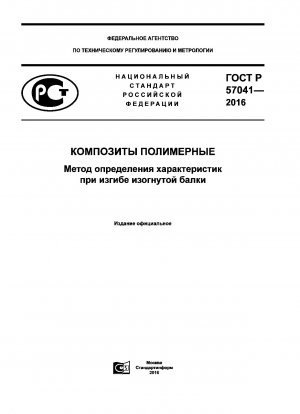ASTM D6415/D6415M-06a(2013)
Standard Test Method for Measuring the Curved Beam Strength of a Fiber-Reinforced Polymer-Matrix Composite
- Standard No.
- ASTM D6415/D6415M-06a(2013)
- Release Date
- 2006
- Published By
- American Society for Testing and Materials (ASTM)
- Status
- Replace By
- ASTM D6415/D6415M-22
- Latest
- ASTM D6415/D6415M-22
- Scope
5.1 Out-of-plane stress analyses are not easily performed. Failure criteria are varied and poorly validated. Interlaminar allowables are not readily available. However, stress analysts routinely encounter structural details in which they cannot ignore the out-of-plane loads. This test method is designed to produce out-of-plane structural failure data for structural design and analysis, quality assurance, and research and development. For unidirectional specimens, this test method is designed to produce interlaminar tensile strength data. Factors that influence the curved beam strength and should therefore be reported include the following: material, methods of material preparation, methods of processing and specimen fabrication, specimen preparation, specimen conditioning, environment of testing, speed of testing, time at temperature, void content, and volume percent reinforcement.
1.1 This test method determines the curved beam strength of a continuous fiber-reinforced composite material using a 90° curved beam specimen (Fig. 1 and Fig. 2). The curved beam consists of two straight legs connected by a 90° bend with a 6.4-mm [0.25 in.] inner radius. An out-of-plane (through-the-thickness) tensile stress is produced in the curved region of the specimen when force is applied. This test method is limited to use with composites consisting of layers of fabric or layers of unidirectional fibers.
1.2 This test method may also be used to measure the interlaminar tensile strength if a unidirectional specimen is used where the fibers run continuously along the legs and around the bend.
1.3 This standard does not purport to address all of the safety concerns, if any, associated with its use. It is the responsibility of the user of this standard to establish appropriate safety and health practices and determine the applicability of regulatory limitations prior to use.
1.4 The values stated in either SI units or inch-pound units are to be regarded separately as standard. Within the text the inch-pound units are shown in brackets. The values stated in each system are not exact equivalents; therefore, each system must be used independently of the other. Combining values from the two systems may result in nonconformance with the standard.
ASTM D6415/D6415M-06a(2013) history
- 2022 ASTM D6415/D6415M-22 Standard Test Method for Measuring the Curved Beam Strength of a Fiber-Reinforced Polymer-Matrix Composite
- 2006 ASTM D6415/D6415M-06a(2013) Standard Test Method for Measuring the Curved Beam Strength of a Fiber-Reinforced Polymer-Matrix Composite
- 2006 ASTM D6415/D6415M-06ae1 Standard Test Method for Measuring the Curved Beam Strength of a Fiber-Reinforced Polymer-Matrix Composite
- 2006 ASTM D6415/D6415M-06a Standard Test Method for Measuring the Curved Beam Strength of a Fiber-Reinforced Polymer-Matrix Composite
- 2006 ASTM D6415/D6415M-06 Standard Test Method for Measuring the Curved Beam Strength of a Fiber-Reinforced Polymer-Matrix Composite
- 1999 ASTM D6415-99e1 Standard Test Method for Measuring the Curved Beam Stength of a Fiber-Reinforced Polymer-Matrix Composite
